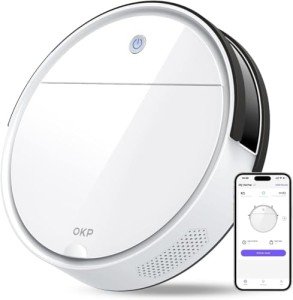
Robot Mop UK
FollowOverview
-
Date de fondation 13 novembre 1994
-
Secteurs Services
-
Posted Jobs 0
-
Vues 46
L'entreprise
A Intermediate Guide For Automatic Hoovers
The Rise of the Robots: A Comprehensive Look at Automatic Hoovers
In today’s hectic world, convenience reigns supreme. From immediate coffee to smart homes, innovation is constantly developing to streamline our lives and complimentary up our precious time. One such innovation that has acquired considerable traction in the last few years is the automatic hoover, more officially known as a robot vacuum. These smart little devices are no longer a futuristic fantasy but a useful truth for millions, offering a hands-free technique to maintaining clean floors.
But beyond the initial appeal of technological novelty, what are automatic hoovers genuinely about? How do they work, what are their benefits, and are they the ideal cleaning option for every home? This article dives deep into the world of automatic hoovers, exploring their performances, ranges, benefits, and everything you require to know before welcoming one into your home.
Exploring the Mechanics of Automatic Cleaning
At their core, automatic hoovers are designed to navigate your home autonomously and tidy floors without direct human control. They achieve this through a combination of sophisticated technologies, consisting of sensors, navigation systems, and cleaning mechanisms.
Many automatic hoovers run on rechargeable batteries and come with a charging dock. When their battery is low, or after finishing a cleaning cycle, they instantly go back to their dock to recharge. The cleaning process itself usually includes:
-
Navigation: This is arguably the most crucial element. Automatic hoovers utilize different navigation techniques to map and robotvacuummops traverse your home. Early models often used bump-and-go navigation, randomly bouncing around up until they covered a location. However, modern-day designs utilize more sophisticated systems like:
- SLAM (Simultaneous Localization and Mapping): This innovation enables the robot to construct a map of its environments in real-time while concurrently identifying its place within that map.
- LiDAR (Light Detection and Ranging): LiDAR utilizes laser beams to measure distances and develop highly accurate maps, enabling efficient and systematic cleaning patterns.
- VSLAM (Visual Simultaneous Localization and Mapping): Similar to SLAM but relies on cameras rather of lasers to perceive and map the environment.
- Gyroscope and Odometry: Some designs combine gyroscopes and wheel sensing units (odometry) to track movement and direction, enhancing navigation.
-
Sensors: A plethora of sensing units are integrated to help the robot hoover engage safely and successfully with its environment. These commonly include:
- Cliff sensors: Prevent the robot from dropping stairs or ledges.
- Challenge sensors: Detect barriers like furnishings, walls, and pet bowls, enabling the robot to navigate around them.
- Wall sensors: Enable the robot to follow walls and edges for extensive edge cleaning.
- Dirt detection sensors: In some innovative models, these sensing units can find locations with higher concentrations of dirt and particles, prompting more focused cleaning.
-
Cleaning Mechanisms: Automatic hoovers normally employ a mix of:
- Rotating brushes: These brushes sweep dirt and debris from the floor towards the suction inlet. They often come in various designs for different floor types.
- Side brushes: Extend the cleaning reach to edges and corners.
- Suction: Generates air flow to raise dirt and dust into the dustbin. Suction power varies in between designs.
- Mopping pads: Some hybrid models include mopping functionality, utilizing moist pads to carefully mop difficult floorings after or throughout vacuuming.
Types of Automatic Hoovers: From Basic to Feature-Rich
The market for automatic hoovers varies, dealing with a broad variety of needs and budgets. They can be broadly categorized based on their features and functionalities:
-
Basic Models: These are typically entry-level robots focusing on fundamental cleaning. They often use bump-and-go navigation or easier gyroscope-based navigation. They are usually more budget friendly but may lack sophisticated features like mapping, app control, or strong suction.
-
Mid-Range Models: Offering a balance between price and features, these models frequently include smart navigation (SLAM, LiDAR, or VSLAM), app connectivity, and scheduling capabilities. They typically supply more efficient cleaning patterns and better obstacle avoidance than fundamental models.
-
High-End Models: These are the exceptional offerings, loaded with advanced technologies and features. They often boast superior navigation, mapping abilities, multi-floor mapping (remembering maps for different levels of your home), personalized cleaning zones, « no-go » zones (locations you wish to avoid cleaning), self-emptying dustbins, and combination with smart home ecosystems.
-
Hybrid Vacuum-Mop Models: These flexible robots combine vacuuming and mopping functionalities in one device. They can vacuum up dry debris and after that mop hard floors with a wet pad, offering a two-in-one cleaning solution.
-
Specialized Models: Certain automatic hoovers are created with particular requirements in mind, such as designs enhanced for pet hair elimination with powerful suction and tangle-free brushes, or designs created for homes with carpets, including carpet increase technology to increase suction power on carpeted surface areas.
The Benefits of Embracing Automatic Cleaning
The popularity of automatic hoovers originates from the various benefits they offer:
- Convenience and Time-Saving: The most significant advantage is undoubtedly the hands-free cleaning experience. You can set them to clean while you are at work, running errands, or merely relaxing, freeing up important time.
- Constant Cleaning: Automatic hoovers can be scheduled to clean regularly, ensuring constant floor tidiness and reducing the buildup of dust and allergens.
- Availability: For senior people or those with movement problems, automatic hoovers can provide a vital aid in preserving a tidy home without physical stress.
- Pet Hair Management: Automatic hoovers, particularly models created for pet owners, work at catching pet hair, dander, and irritants, contributing to a healthier home environment.
- Improved Air Quality: By routinely removing dust and irritants, automatic hoovers can add to better indoor air quality, particularly useful for individuals with allergies or respiratory level of sensitivities.
- Reaching Under Furniture: Their low profile enables them to clean up under beds, sofas, and other furniture where standard vacuums frequently struggle to reach.
Picking the Right Automatic Hoover for Your Home
Picking the ideal automatic hoover depends on individual requirements and home qualities. Think about these factors when making your option:
- Floor Types: Determine the primary floor types in your home (wood, carpet, tile, etc). Some designs are much better matched for specific floor types. Check if the design is developed for carpets if you have considerable carpeted locations.
- Home Size and Layout: Larger homes may gain from models with longer battery life and advanced mapping abilities for effective cleaning. Complex designs with multiple spaces and barriers may require robots with exceptional navigation.
- Budget plan: Automatic hoovers differ substantially in rate. Establish a spending plan and check out models within your price range that provide the features you require.
- Features: Prioritize features based upon your needs. Consider:
- Navigation System: SLAM, LiDAR, VSLAM for efficient and methodical cleaning.
- App Control and Smart Features: Scheduling, zone cleaning, no-go zones, smart home integration.
- Suction Power: Higher suction for pet hair and carpets.
- Battery Life: Longer run time for larger homes.
- Self-Emptying Dustbin: For added convenience and less regular maintenance.
- Mopping Functionality: If you want to mop tough floors as well.
- Sound Level: Consider designs with lower sound levels if noise level of sensitivity is an issue.
Maintaining Your Automatic Hoover

To guarantee ideal efficiency and longevity, regular upkeep is essential:
- Empty the Dustbin Regularly: Frequent clearing prevents the dustbin from overfilling and maintains suction efficiency. Self-emptying models lower this task significantly.
- Tidy Brushes and Filters: Hair and debris can accumulate on brushes and filters, lowering cleaning effectiveness. Clean them regularly according to the producer’s instructions.
- Inspect Sensors: Ensure sensors are clean and devoid of dust or obstructions for correct navigation.
- Change Parts as Needed: Brushes and filters will eventually need replacement. Follow the producer’s recommendations for replacement intervals.
- Battery Care: While typically long-lasting, batteries have a life-span. Follow charging guidelines and prevent leaving the robot continually on the battery charger when fully credited maximize battery health.
The Future is Autonomous Cleaning

Automatic hoover technology is constantly progressing. We can anticipate to see further developments in:
- Improved AI and Navigation: Robots will end up being even smarter at browsing complex environments, preventing challenges, and discovering cleaning preferences.
- Enhanced Mapping and Customization: More detailed and precise mapping, permitting extremely tailored cleaning routines and zone control.
- Greater Integration with Smart Home Ecosystems: Seamless integration with voice assistants and other smart home devices for enhanced control and automation.
- More Versatile Cleaning Capabilities: Potentially integrating more sophisticated cleaning functions beyond simply vacuuming and mopping.
Conclusion: Embracing the Helping Hand of Automation
Automatic hoovers represent a considerable advance in home cleaning innovation, using convenience, effectiveness, and consistent cleanliness. While not a complete replacement for standard deep cleaning in all scenarios, they are indispensable tools for preserving everyday floor cleanliness, maximizing time, and enhancing the overall convenience of your home. By comprehending their performances, types, and features, you can make a notified choice and choose the automatic hoover that best matches your unique needs and way of life, embracing the future of automated cleaning.
Regularly Asked Questions (FAQs) about Automatic Hoovers
Q1: Are automatic hoovers as powerful as standard vacuum cleaners?A: While suction power has substantially enhanced in current designs, many automatic hoovers may not match the deep cleaning power of a high-end conventional upright or cylinder vacuum, particularly for greatly stained areas or thick carpets. However, for daily cleaning and upkeep, they are usually really efficient.
Q2: Can automatic hoovers clean all types of floors?A: Many automatic hoovers are created to work well on various floor types, including hardwood, tile, laminate, and low-pile carpets. Nevertheless, some designs are much better matched for specific floor types. Inspect item specs to guarantee compatibility with your flooring.
Q3: How long do automatic hoover batteries last?A: Battery life varies depending upon the design and cleaning mode. Many designs provide between 60 to 120 minutes of run time on a single charge. Higher-end designs may offer even longer battery life.
Q4: Are automatic hoovers noisy?A: Noise levels differ amongst designs. Typically, they are quieter than traditional vacuum cleaners, but some noise is still generated. Consider designs with lower decibel rankings if sound level of sensitivity is a concern.
Q5: Do automatic hoovers require a great deal of upkeep?A: Routine maintenance is essential, including emptying the dustbin, cleaning brushes and filters, and sometimes examining sensing units. Self-emptying designs minimize the frequency of dustbin emptying.
Q6: Can automatic hoovers handle pet hair effectively?A: Yes, numerous automatic hoovers are specifically designed for pet owners and are highly efficient at picking up pet hair. Try to find designs with features like tangle-free brushes and strong suction, typically marketed as « pet hair » models.
Q7: What happens if an automatic hoover gets stuck?A: Modern automatic hoovers are geared up with barrier sensing units and navigation systems to reduce getting stuck. However, they might sometimes get stuck on cables, loose rugs, or in tight areas. A lot of designs will stop and signify if they are stuck, frequently through an app notice.
Q8: Can I control an automatic hoover from another location?A: Many mid-range and high-end models include smartphone app connectivity, permitting push-button control, scheduling, monitoring cleaning status, and accessing functions like zone cleaning and no-go zones.
Q9: Are automatic hoovers worth the financial investment?A: Whether they are « worth it » depends upon private requirements and top priorities. If benefit, time-saving, and consistent cleaning are very important to you, an automatic hoover can be a valuable investment. Consider your way of life, budget, and cleaning needs to make an informed choice.
Q10: Can automatic hoovers clean in the dark?A: Yes, most automatic hoovers can clean up in low light conditions or perhaps darkness. They count on their sensing units and navigation systems, which are normally not depending on ambient light for fundamental operation. Designs with visual navigation might perform efficiently in enough lighting, however are typically created to operate in regular family lighting conditions.


